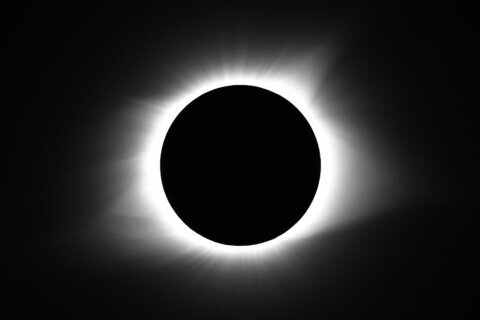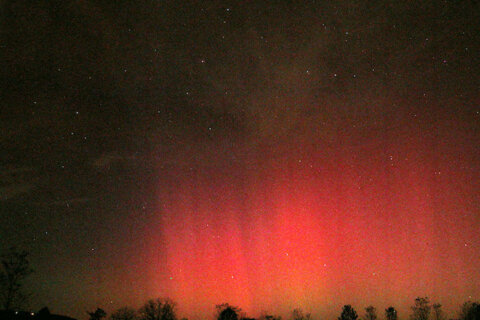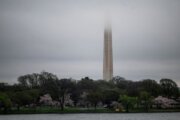What better way to mark my 18th year as WTOP’s space reporter than a solar eclipse! A month from now, on April 8, the sun and new moon will meet in the daytime skies over North America to create a sky sight without compare — an eclipse of the sun.
For some viewers, the sun will be totally eclipsed by the new moon, while for the vast majority of viewers, the sun will be only partially eclipsed.
By now you hopefully know about the eclipse. If not, you can get caught up on details, including livestream links, weather prospects and photographing the eclipse.
More on the solar eclipse:
Get the particulars of the solar eclipse for where you will be during the event, by going to this interactive map, which shows the whole U.S. Google-map-style and allows you to pinpoint your location. All of the information about the eclipse at your viewing spot pops up — it is really nifty.
The moon and the 2024 total solar eclipse
Deep partial solar eclipse in the DMV
If you are staying put in the D.C. area, you can only witness a deep partial solar eclipse as we are not in the path of totality.
In D.C., the new moon will start to cross the face of the sun at 2:04 p.m. and obscure 89% of the sun at maximum eclipse which occurs at 3:20 p.m. The eclipse ends at 4:32 p.m.
Safety First
If you are viewing the eclipse with others, especially children, make sure they protect their eyes according to the following guidance. Solar eclipse observers have to follow safe sun viewing procedures as failure to do so could result in an eye injury.
Here is everything you need to know about eye safety and how to safely view the solar eclipse.
If you plan on wearing solar eclipse glasses, or using an optical aid such as a camera or smartphone, you need to order the appropriate items now to insure you will have them on eclipse day.
In 2017, there were solar filter/viewer products that did not meet the strict ISO standard and presented a danger to the public.
For your eye safety, the American Astronomical Society (AAS) has a list of vendors on its website that sell safe products for viewing the eclipse.
“Important: We do not recommend searching for eclipse glasses on Amazon, eBay, Temu, or any other online marketplace and buying from whichever vendor offers the lowest price. Before you buy a solar viewer or filter online, we recommend that you make sure that (1) the seller is identified on the site and (2) the seller is listed on this page,” American Astronomical Society said on its website.
Eclipse Events
Where to get free solar eclipse glasses
From the National Air and Space Museum:
“Beginning in late March, the museum will hand out limited supplies of solar eclipse glasses at the National Air and Space Museum in Washington, D.C., and its Steven F. Udvar-Hazy Center in Chantilly, Virginia. Glasses will also be handed out on the National Mall during the eclipse April 8. Solar eclipse glasses are provided by the National Oceanic and Atmospheric Administration (NOAA), the U.S. National Science Foundation (NSF) and NASA.”
The museum will share full details on how to pick up a pair solar eclipse glasses on its website on Friday, March 15.
“Great American Eclipse” film premiere
The Public Broadcasting Service (PBS) science series NOVA is premiering a new film on the 2024 solar eclipse called “Great American Eclipse” on Wednesday, April 3, at 8 p.m.
Steven F. Udvar-Hazy Center
Visitors will be able to view the eclipse through safe solar telescopes in Chantilly, Virginia, from 2 to 4 p.m.
Date/time: April 8 from 2-4 p.m.
Location: 14390 Air and Space Museum Parkway Chantilly, Virginia 20151
For those not in the D.C. area, the museum has compiled a map of eclipse-viewing events taking place at Smithsonian Affiliates across the U.S. The map features over 15 events, with additional events being added.
NASA’s events
NASA is hosting many eclipse events across the U.S. and online. There are several in the D.C. area or nearby:
GLOBE Observer Connect: Eclipses and Cloud Processes VIRTUAL
“Join us for the March GLOBE Observer Connect to learn from Marilé Colón Robles, GLOBE Clouds project scientist at NASA’s Langley Research Center, about the different processes by which clouds form and how the eclipse may have an impact on those processes,” event organizers wrote online.
Date/time: March 21 at 8 p.m.
Host: GLOBE Observer (NASA Goddard) and the GLOBE Clouds Team (NASA Langley)
Location: 1 NASA Dr., Hampton, Virginia 23666
Solar Eclipse Festival on the National Mall
“Celebrate and observe the solar eclipse that will be visible all across North America on Monday, April 8! The National Air and Space Museum, in collaboration with other Smithsonian museums, NASA, NOAA, the National Science Foundation, and the National Radio Astronomy Observatory presents an outdoor festival with activities for all ages.
The event will run from 12 to 4 p.m. along the National Mall between 4th and 12th Streets. Browse the many activity stations to view the Sun in a variety of safe telescopes, and explore the different educational offerings from Smithsonian museums and partners,” the museum wrote online.
Date/time: April 8 from 12-4 p.m.
Host: Smithsonian National Air and Space Museum
Location: 600 Independence Ave SW, D.C.
Virtual Eclipse Resources
The museum also has available on its website educational resources that teachers, parents and caregivers can use to teach children about eclipses. This includes hands-on activities, videos and materials that can be incorporated into lesson plans.
NASA Wallops Visitor Center, VA — Solar Eclipse and Multi-Rocket Launch Viewing Event
“Experience an unforgettable afternoon at the NASA Wallops Visitor Center on Monday, April 8, from 1-5 p.m. EDT! Safely witness the awe-inspiring Solar Eclipse, catch the thrilling launch of 3 Black Brant IX sounding rockets for the APEP-2 mission, and explore engaging solar-related activities throughout the visitor center. This event will take place rain or shine,” NASA wrote on its website.
Date/time: April 8 at 1 p.m.
Host: NASA Wallops Flight Facility Visitor Center
Location: 175 Chincoteague Road, Wallops Island, Virginia
“This day is a rare event: a partial solar eclipse in Tidewater, where the Sun will partially (78%) be obscured by the Moon. BBAA will have the Tidewater location set for club members not traveling to the path of totality,” event organizers said.
Date/time: April 8 at 1:50 p.m.
Host: Back Bay Amateur Astronomers
Location: 110 Main St, Newport News, Virginia
Will the ‘Devil Comet’ also be visible?
If you will be in the path of totality, like I will be in Texas, be aware that Comet Pons-Brooks may be visible during totality. I am going to try and image it, and will be on the hunt for it during totality.
Follow Greg Redfern on Facebook, X and his daily blog to keep up with the latest news in astronomy and space exploration.
Get breaking news and daily headlines delivered to your email inbox by signing up here.
© 2024 WTOP. All Rights Reserved. This website is not intended for users located within the European Economic Area.






